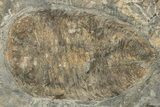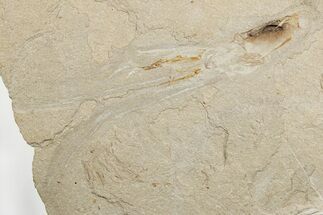6.2" Eudolalites with Selenopeltis Trilobites and a Machaeridian
This is an interesting association from the Upper Tiouririne Formation of Morocco. On this 15.7" wide slab of limestone there is a large, dalmanitid (Eudolalites maiderensis) trilobite along with a pair of Selenopeltis trilobites, an unidentified arthropod, and an armoured annelid worm of the genus Plumulites. The Eudolalites is huge at 6.2" long and the larger Selenopeltis is 4.5". Restoration is pretty minimal along a repaired crack in the slab.
Plumulites is a rare, extinct genus of armored, segmented annelid worms (machaeridians) that existed from the Ordovician period to the Early Triassic period (480-250 MYA). They are relatives of the modern-day earthworm, leech, and bristleworm. Many well-preserved specimens have emerged on the market over the last few years.
About Trilobites
Trilobites were a very diverse group of extinct marine arthropods. They first appeared in the fossil record in the Early Cambrian (521 million years ago) and went extinct during the Permian mass extinction (250 million years ago). They were one of the most successful of the early animals on our planet: over 25,000 species have been described, filling nearly every evolutionary niche. Due in large part to their hard exoskeletons (shells), they left an excellent fossil record.
Trilobites were a very diverse group of extinct marine arthropods. They first appeared in the fossil record in the Early Cambrian (521 million years ago) and went extinct during the Permian mass extinction (250 million years ago). They were one of the most successful of the early animals on our planet: over 25,000 species have been described, filling nearly every evolutionary niche. Due in large part to their hard exoskeletons (shells), they left an excellent fossil record.
$595
SPECIES
Selenopeltis buchi, Eudolalites maiderensis & Plumulites sp.
LOCATION
El Kaid Rami, Morocco
FORMATION
Upper Tiouririne Formation
SIZE
Rock 15.7 x 11", Largest trilobite 6.2"
CATEGORY
SUB CATEGORY
ITEM
#234626
We guarantee the authenticity of all of our specimens.
 Reviews
Reviews













